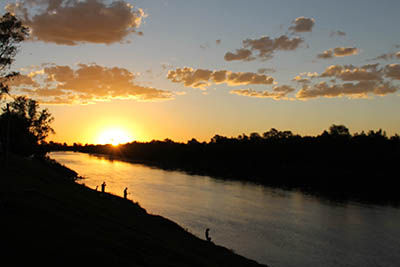
Photo: Leonie Bolleurs |
With water being a valuable and scarce resource in the central regions of South Africa, it is no wonder that the UFS has large interdisciplinary research projects focusing on the conservation of water, as well as the sustainable use of this essential element.
The hydropedology research of Prof Pieter le Roux from the Department of Soil, Crop and Climate Sciences and his team at the UFS focuses on Blue water. Blue water is of critical importance to global health as it is cleared by the soil and stored underground for slow release in marshes, rivers, and deep groundwater. The release of this water bridges the droughts between showers and rain seasons and can stretch over several months and even years. The principles established by Prof Le Roux, now finds application in ecohydrology, urban hydrology, forestry hydrology, and hydrological modelling.
The Department of Agricultural Economics is busy with three research projects for the Water Research Commission of South Africa, with an estimated total budget of R7 million. Prof Henry Jordaan from this department is conducting research on the water footprint of selected field and forage crops, and the food products derived from these crops. The aim is to assess the impact of producing the food products on the scarce freshwater resource to inform policy makers, water managers and water users towards the sustainable use of freshwater for food production.
With his research, Prof Bennie Grové, also from this department, focuses on economically optimising water and electricity use in irrigated agriculture. The first project aims to optimise the adoption of technology for irrigation practices and irrigation system should water allocations to farmers were to be decreased in a catchment because of insufficient freshwater supplies to meet the increasing demand due to the requirements of population growth, economic development and the environment.
In another project, Prof Grové aims to economically evaluate alternative electricity management strategies such as optimally designed irrigation systems and the adoption of new technology to mitigate the substantial increase in electricity costs that puts the profitability of irrigation farming under severe pressure.
Marinda Avenant and her team in the Centre for Environmental Management (CEM), has been involved in the biomonitoring of the Free State rivers, including the Caledon, Modder Riet and part of the Orange River, since 1999. Researchers from the CEM regularly measures the present state of the water quality, algae, riparian vegetation, macro-invertebrates and fish communities in these rivers in order to detect degradation in ecosystem integrity (health).
The CEM has recently completed a project where an interactive vulnerability map and screening-level monitoring protocol for assessing the potential environmental impact of unconventional gas mining by means of hydraulic fracturing was developed. These tools will aid decision making at national level by providing information on the environment’s vulnerability to unconventional gas mining.